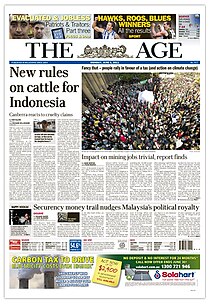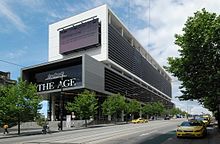The Age
|
|
|
|---|---|

|
|
| description | Daily newspaper from Melbourne, Australia |
| language | English |
| publishing company | Fairfax Media |
| First edition | 1854 |
| Frequency of publication | Every day |
| Sold edition | (2009) 202,000-291,000 copies |
| Range | (2009) 0.697-0.919 million readers |
| Editor-in-chief | Paul Ramadge |
| Web link | theage.com.au |
| ISSN (online) | 0312-6307 |
The Age is a liberal Australian newspaper in broadsheet format , which in since 1854 Melbourne appears. The Age was founded by two businessmen, brothers John and Henry Cooke, who moved to Melbourne from New Zealand in the 1840s . The first edition of The Age appeared on October 17, 1854.
The circulation averages 202,100 copies on weekdays and 291,000 copies on Saturdays. The circulation of the Sunday appearing The Sunday Age is 228,600. According to The Age, the average reach from Monday to Friday is 699,000, Saturday 919,000 and Sunday 697,000 readers.
history
The two businessmen's venture was initially unsuccessful and they had to sell the newspaper almost two years later, in June 1856. Journalist Ebenezer Syme and Scottish- born ironmonger James McEwan bought the paper at auction for £ 2,000. The first issue under the new owners appeared on June 17, 1856. However, Ebenezer Syme was soon elected to the Victoria State Parliament and his brother David Syme took more and more control of the newspaper. With the death of his brother in 1860, he became the ultimate managing director and editor-in-chief, a title which he, however, strictly rejected, and remained so until his death in 1908. It is thanks to him that The Age became the leading newspaper in Victoria . The circulation soon exceeded that of its competitors The Herald and The Argus . In 1899 it was already reaching 120,000 copies per day.
After the death of David Syme, his sons took over the management of the newspaper. Herbert Syme became managing director and his brother Geoffrey became editor-in-chief. Under their control, The Age became more conservative, resisting the trend of having photos on the front page until World War II. Since it was forbidden by will of David Symes sons to sell shares in the newspaper in order to raise new capital for necessary modernizations, both the political influence and the circulation figures decreased during this time.
After Herbert's death in 1942, Oswald, the last son of David Syme, took over the management of the newspaper. He carried out the overdue modernization of the newspaper and adapted the reporting and appearance to the standards customary at the time. This became possible because a court, at his instigation, overturned the last will of David Syme. This enables Oswald to sell shares in the company and thus raise new capital for investments in new technical equipment. To this end, David Symes & Co. was listed on the stock exchange. Until his departure in 1964, The Age recovered financially - also benefiting from the fact that the competitor The Argus was discontinued in 1957. At that time, John Fairfax Holding , owner of the Sydney Morning Herald , among others, tried to take over The Age for the first time.
Ranald Macdonald, grandson and successor of Oswald Symes, introduced many innovations, such as the Sunday and evening editions, and hired Graham Perkin as the first editor-in-chief from outside the family. Perkin transformed the arch-conservative newspaper into a left-wing liberal medium that, for example, rejected the death penalty and addressed racism. In the 1972 election campaign, The Age supported the Australian Labor Party under Gough Whitlam .
Between 1966 and 1983 Fairfax successively David Syme and Co. took over the name of the reorganized Fairfax subsidiary and thus the long-standing owner family vanished in 1999 with the name change to The Age Company Ltd .
In January 1995, The Age became the first Australian newspaper to publish its articles on the Internet.
On June 18, 2012, Fairfax Media announced, as Fairfax Holdings has been operating for a number of years, that The Age will appear in tabloid format from March 2013, i.e. the format corresponding to a classic tabloid . The sister newspaper The Sydney Morning Herald is also to be converted. The Age's website is to be paid at least in part. On the same day, Fairfax Media announced the closure of the group's two largest printing plants in Melbourne's Tullamarine and Sydney's Chullora in June 2013 and the layoff of 1,900 employees within the next three years. These are related to the ongoing collapse of the traditional financing model for print media in the age of the Internet.
Web links
- "The Age" Homepage (English)
- History of "The Age" since 1854 (English) ( Memento of 14 October 2009 at the Internet Archive )
- Half a century of obscurity (Sybil Nolan on the story of "The Age"; PDF; 100 kB)
- "The Age" 's new media center ( Memento from October 14, 2009 in the Internet Archive )
- Sir Geoffrey Syme "Sir Geoffrey Syme Journalist & Managing Editor of" The Age "from 1908 until 1942" (English)
Individual evidence
- ^ The Age - Brand Overview. (No longer available online.) December 2009, archived from the original on January 25, 2013 ; accessed on February 23, 2010 (English). Info: The archive link was inserted automatically and has not yet been checked. Please check the original and archive link according to the instructions and then remove this notice.
- ↑ a b c d e The Story of The Age . (No longer available online.) Archived from the original on January 13, 2010 ; accessed on February 23, 2010 (English). Info: The archive link was inserted automatically and has not yet been checked. Please check the original and archive link according to the instructions and then remove this notice.
- ^ Sybil Nolan: Half a century of obscurity, The Age, 1908-1964. (PDF; 100 kB) (No longer available online.) Archived from the original on October 6, 2009 ; accessed on February 23, 2010 (English). Info: The archive link was inserted automatically and has not yet been checked. Please check the original and archive link according to the instructions and then remove this notice.
